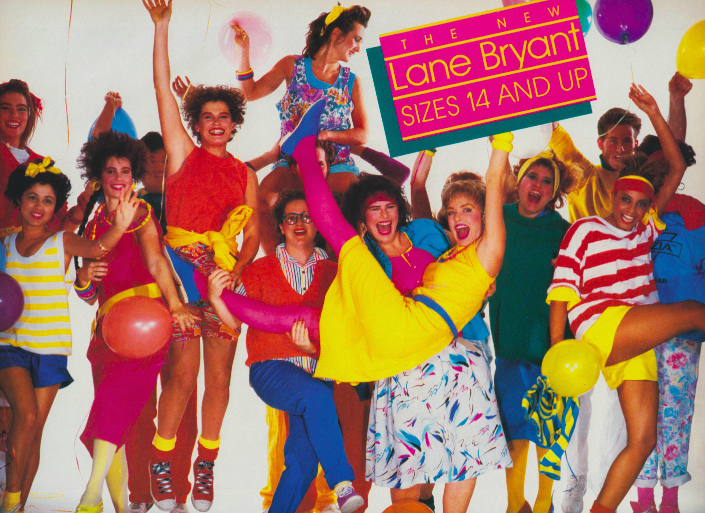
REFERRING BOTH TO BODIES and to dress, the term ‘plus-size’ lends a hefty weight to the hackneyed notion that ‘you are what you wear’. It has only been within the past few years, however, that plus-size has become the lexical ground zero in the United States for debates within and outside the industry over everything from beauty ideals to consumer equity. Yet, with Lane Bryant CEO Linda Heasley scrubbing the brand’s marketing materials of the term,1 and as models and ‘real’ women alike organise to abolish it via the social media campaign #DropThePlus,2 plus-size may soon go the way of other terms such as ‘enbonpoint’, ‘stout’ and ‘Junoesque’ as the preferred euphemism to refer to the fat body in fashion.
Amid these controversies, there is perhaps no better time than the present to consider the etymology and the shifting meanings and uses of one of fashion’s most contested term. One way to think about plus-size is as a discursive formation, or as ‘a group of statements [that] provide a language for thinking about…a particular topic at a particular historical moment.’3 As it is conceived by philosopher Michel Foucault in his seminal text The Archaeology of Knowledge, a discursive formation is not ‘a slender surface of contact between a reality and a language,’ but rather it is comprised of a group of statements ‘that systematically form the objects of which they speak.’4 Plus-size, thus defined as a discursive formation, may therefore be understood not only as a term created by the fashion industry to refer to large-size garments (in contemporary sizes, US sizes 14 and above), but rather as a nebulous concept formed by overlapping terms and ideologies (both textual and visual) that actually function to render intelligible or to discursively create ‘plus-size bodies’. Through such a reading, plus-size underscores the ambivalent manner in which the fashion industry – a cultural field in which thinness is privileged – has historically dealt with and addressed the fat body, but also foregrounds cultural anxieties toward fat.
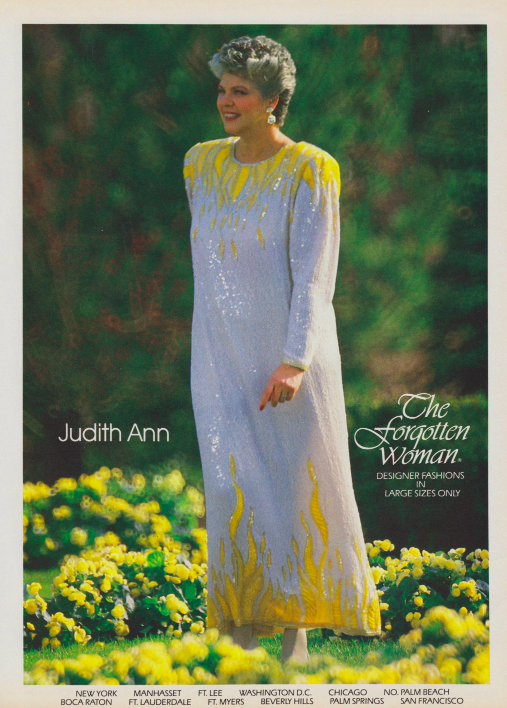
As such, in spite of the current fervour for plus-size, historically speaking, the term initially functioned as little more than utilitarian catchall devised by garment manufacturers to refer to dress for bigger bodies, but not to bodies themselves. While it did not fall into wider use until the 1940s, plus-size was first invoked by the industry in an advertisement that ran in the July 5, 1927 issue of Women’s Wear Daily (WWD). Advertising ‘Incomparably Choice, Smart, Graceful, Slenderizing Plus-Size Frocks and Gowns,’ Wm. Hendricks, Inc. catered to women whose bodies did not conform to the fashionable, gamine silhouette of the late Twenties, but who nevertheless aspired to attain a fashionable ideal. However, although this period is frequently lauded by fashion historians as one in which the tenets of modernism influenced fashion – emphasising, in fashion scholar Elizabeth Wilson’s words, an ‘angular, two-dimensional style’5 that was reflected in the streamlined boyish silhouette of the flapper – it was also a moment in fashion that, quite contradictorily, was perhaps more accommodating of the fat body as numerous advertisements and editorials attest.
Although the Wm. Hendricks Inc. advertisement stands as the first instance of plus-size appearing in American fashion media, it is nevertheless an isolated example. Rather, throughout the 1920s and Thirties, the seemingly pejorative stout was the preferred euphemism to refer to both fat bodies and dress, and was used interchangeably with a litany of other antiquated terms like ‘gracious’, ‘regal’, ‘outsize’ and, of course, ‘plus-size’. Proliferating in industry periodicals like WWD and popular fashion magazines alike, the discourse of stout framed excesses fat as an aesthetic challenge, certainly, but not as a problem per se, nor as a medical malady.
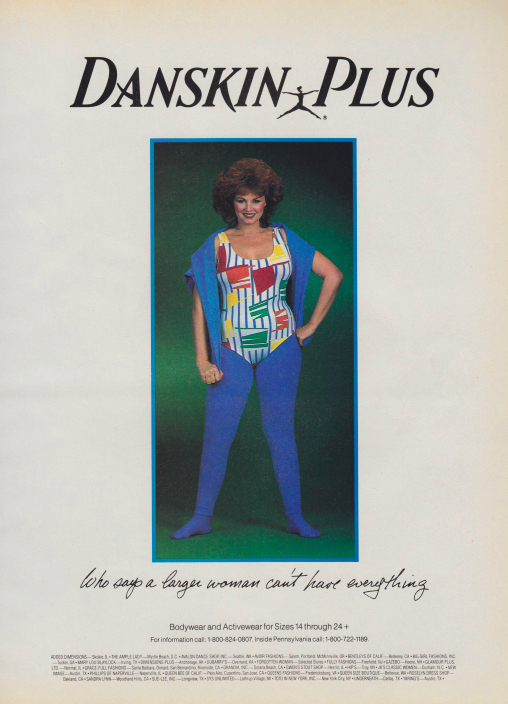
Indeed, as exemplified in a fictional story entitled ‘Too Many Pounds Spoil the Silhouette’ that appeared in the January 1921 issue of Vogue, Japonica, the stout heroine of the story, is told by her doctor that she need not worry about shedding pounds. ‘The whole physique of the individual must be taken into account,’ he says, furthering that one’s ideal weight ‘does not correspond with ideal weight as Paris considers it to be.’6 Appearing alongside advertisements that promised ‘Lissom Grace and Youthful Lines for the Woman above average weight’, and ‘Correct Spring Summer Modes for Stout Women’, stout fashions were framed as the artifice that could compliment and flatter fat bodies.
In the decades to follow, however, this discourse would shift markedly. As the United States asserted itself on the global fashion stage, the so-called ‘American Look’ emerged as the de-facto beauty ideal – or, ‘that certain kind of American figure: long-legged, broad-shouldered, slim-waisted, high-bosomed,’7 that could only be cultivated through a strict diet and exercise. As might be expected, this did not bode well for the fat woman in fashion. Increasingly, references to stout disappeared from the pages of American fashion magazines, and were replaced with countless diet and exercise articles, and by advertisements for gimmicky pills and machines that promised rapid weight loss. Furthermore, the advances in the American industrial food complex and an increasingly sedentary, suburban lifestyle, paralleled with an intensification of diet culture, created an ambivalent and contradictory ideological climate in which even as Americans were gaining weight, slimness and dieting came to be perceived as particularly American virtues. Fatness therefore shifted from being a minor health concern or a mar to fashionable aesthetics, to serving as a ‘symbolic message of laziness and moral failure.’8
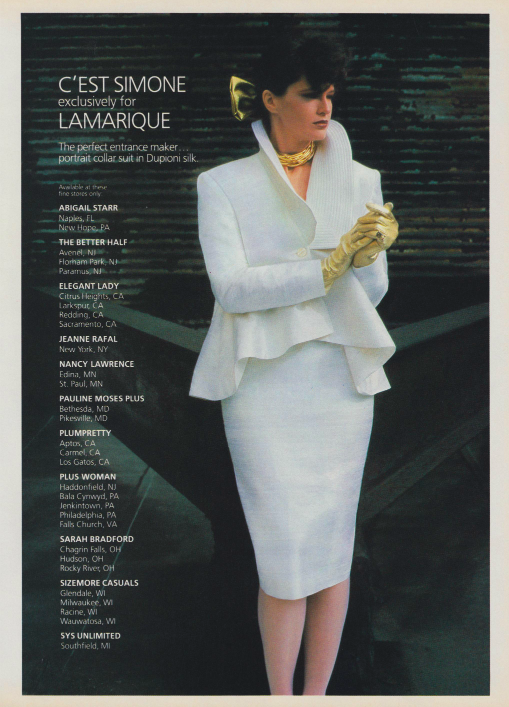
Alongside these ideological shifts, American fashions became both more simple and more revealing, and stiff corsetry was replaced with girdles made of silk and elastic that promised a ‘gentle re-alignment of proportions, [but] never, never displacement of inches.’9 In this climate, the fat woman could no longer rely upon dress to cut a fashionable silhouette; the body itself had to conform to fashion’s ideal. An outright hostility could even be glimpsed in articles like one that appeared in the December 1944 issue of Vogue, which explained that while ‘almost any figure looks better in a scant bathing suit […] it is definitely out of bounds for any figure that is in any way let go. [But] of course (let’s come right out and say it) no fat woman can wear one.’10 This escalating neglect of and hostility toward the fat body in fashion was further underscored in a 1946 New York Times article entitled ‘Clothes Problem for Stout Women’. In this brief article, the author noted that stout, female consumers (then cited as 4.5% of the population) were being overlooked and underserved with manufacturers refusing to produce large-size garments in order to maximise profits – a state of affairs that was perhaps a holdover from the L-85 textile restrictions that were implemented during World War II.11
Even so, it is during this moment that plus-size, quite evocatively, emerges as the preferred term for referring to large-size dress, and, increasingly, to bodies. These references, however, are – perhaps unsurprisingly – scant in extant fashion media. Throughout the 1940s and 1950s plus-size was relegated to small advertisements and the fine print as fashion’s literal footnote, appearing only occasionally in ads for mail-order girdles, and as a size option to be ticked off. More often than not, references to large-size garments were rendered in a sort of code with plus-size vaguely encompassing sizes 44 or 46 and above (before America adopted its current sizing conventions). Even Lane Bryant – which even then was the United States’ largest retailer of large-size garments – did not explicitly reference plus-size or to feature representations of fat women in their advertisements, preferring instead to promote their main lines.
With cultural attitudes toward fat shifting so rapidly, the discourse of plus-size thus disappeared from American fashion media almost as quickly as it fell into favour, and, as one New York Times article wrote, the fat consumer quickly became fashion’s ‘forgotten woman’.12 Fashion’s longstanding ambivalence toward fat, though, is perhaps best summarised by the following quotation by Vogue editor Edna Woolman Chase, which appeared in the November 1954 issue of Life. Reflecting on her tenure at Vogue from 1914-52, Woolman recounted, ‘Once Vogue showed two or three dresses for stout women, but were so shaken by the experience we haven’t repeated it […] Today we acknowledge that a lady may grow mature, but she may never grow stout.’13
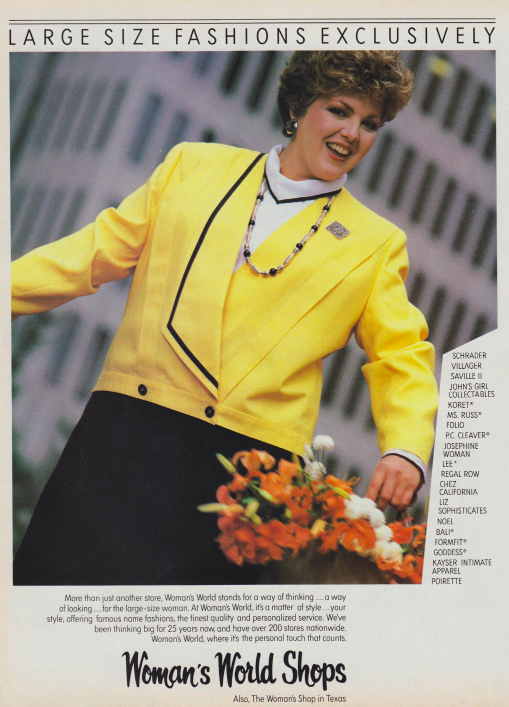
Amid fears of the impending ‘obesity epidemic’, with the short-lived 1980s Vogue advertorial entitled ‘Fashion Plus’, plus-size once again surfaced as fashion’s preferred euphemism for both fat bodies and large-size garments. It wasn’t until about 2010 with V’s much-talked about ‘Size’ issue featuring actress Gabourey Sidibe as a cover girl, however, that these debates intensified and plus-size became political. Certainly, as Americans are getting fatter – the most recent figures from the Centers for Disease Control and Prevention estimate that over one third of the population is overweight14 – it is therefore no surprise that plus-size has become a semiotic battleground as fat consumers seek retail equality in the age of democratic fashion. Functioning as fashion’s discursive footnote, plus-size closely mirrors the increasingly marginal place the fat body has come to hold in American culture over the past century.
If, as fashion theorist Joanne Entwistle holds, dress is a situated bodily practice,15 a dialectical relation may be glimpsed between fashion and the fat body, each working to imbue the other with meaning – as plus-size – in a culture that reviles fat. Indeed, as fashion scholar Agnès Rocamora has written, since discourse ‘is a space of knowledge with porous boundaries, a wide constituency of layered nodes and ideas, themes and concepts that cut across disciplines and fields,’16 plus-size as a concept has extended far beyond the field of fashion in becoming synonymous with the fat body itself. Yet, amid the current campaigns to abolish plus-size, what will happen to the fat woman when plus-size become taboo? Is fashion ready to open its arms, extend size ranges and to see beyond normative beauty ideals? Or will she again become fashion’s forgotten woman?
Lauren Downing Peters is a PhD candidate at the Centre for Fashion Studies at Stockholm University.
See D Mau, “Lane Bryant Wants to ‘Change the Conversation’ About Plus-size,” Fashionista, April 6, 2015, accessed April 22, 2015, http://fashionista.com/2015/04/lane-bryant-imnoangel-campaign ↩
See Z Tsjeng, “#DropThePlus calls on fashion to stop using ‘plus-size’” in Dazed, March 27, 2015, accessed April 22, 2015, http://www.dazeddigital.com/fashion/article/24248/1/droptheplus-calls-on-fashion-to-stop-using-plus-size ↩
S Hall, “The Work of Representation” in Representation: Cultural Representations and Signifying Practices, ed. Stuart Hall Sage, London, 1997, p. 44 ↩
M Foucault, The Archaeology of Knowledge: And The Discourse on Language, Vintage Books, New York 2010 [1st ed. 1969], p.38. ↩
E Wilson, Adorned in Dreams: Fashion and Modernity (New Brunswick: Rutgers University Press, 1985), 62. ↩
“Too Many Pounds Spoil the Silhouette” in Vogue, January 1921, p.92 ↩
“What is the American Look?” in Life, May 21, 1945, p.87 ↩
P Stearns, Fat History: Bodies and Beauty in the Modern West, New York University Press, New York, 1997, p. 117 ↩
“Corset Situation Easing Up,” Vogue (November 1945), 182. ↩
“How Much Can You Bare” in Vogue, December 1944, p. 80 ↩
It is unclear how much of an impact the L-85 textile rationing rules had on the plus-size industry, but this article is nevertheless an interesting insight. “Clothes Problem for Stout Women,” The New York Times, April 20, 1946, accessed April 20, 2015, http://timesmachine.nytimes.com/timesmachine/1946/04/20/84637124.html?pageNumber=18 ↩
“The Forgotten Woman in the ‘Skinny Revolution’” in The New York Times, December 1, 1969 (accessed April 24, 2015), http://timesmachine.nytimes.com/timesmachine/1969/12/01/89387415.html?pageNumber=58 ↩
“Men are the Latest of her Many Targets,” Life, November 8, 1954, p. 127. ↩
See “Adult Obesity Facts,” Centers for Diseaes Control and Prevention, accessed April 28, 2015, http://www.cdc.gov/obesity/data/adult.html ↩
J Entwistle, The Fashioned Body, Polity, London, 2000 ↩
A Rocamora, Fashioning the City: Paris, Fashion and the Media, I.B. Tauris, London, 2009, p. 57 ↩